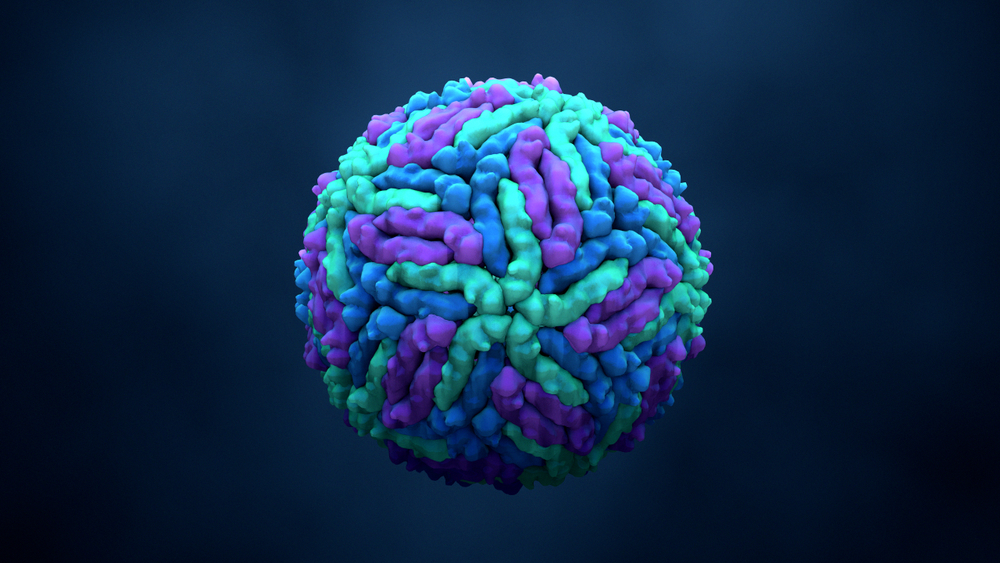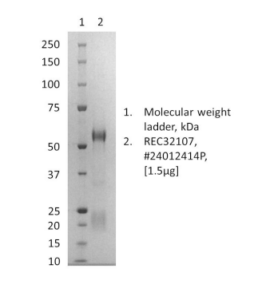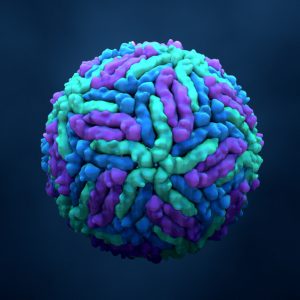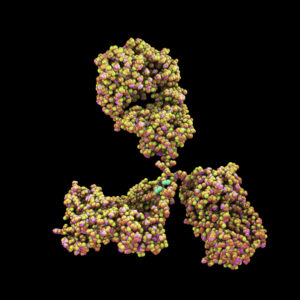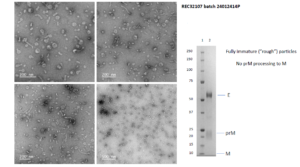
EM: Representative Electron microscopy image of Zika virus-like particles, immature.
Zika virus-like particles, immature
$1,425.18 excl. VAT
Zika virus-like particles (VLPs) expressed in HEK293 cells and purified from cultrue supernatant; The furin cleavage site in the prM protein has been altered and inactivated. This product is especially recommended for diagnostic assay developers, as it is ideal for sensitive assays.
Zika virus-like particles, immature
Zika virus-like particles (VLPs) expressed in HEK293 cells and purified from culture supernatant; The furin cleavage site in the prM protein has been altered and inactivated.
Recombinant Zika virus-like particles consisting of Envelope, pre-Membrane and Membrane protein produced in mammalian HEK293 human cells. Blocking furin cleavage of the prM protein of Zika VLPs leads to a more homogenous population of particles that show greater stability purity than our best-selling Zika VLPs which showed a mix of cleaved and uncleaved prM protein. This product is especially recommended for diagnostic assay developers, as it is ideal for sensitive assays. Bulk quantities available, please contact us at NAC.Contact@LGCGroup.com to enquire about the special discount!
PRODUCT DETAILS – Zika virus-like particles, immature
- Recombinant Zika virus-like particle comprising Envelope (E), pre-Membrane (prM) and Membrane (M), Includes amino acids 123-819 (strain Suriname Z1106033, NCBI Accession Number: ALX35659.1).
- Expressed and prurified from HEK293 cells.
- Greater than 95% purity by SDS-PAGE.
- Presented in buffered in DPBS pH 7.4, 20% sucrose. May contain traces of tartrate.
- Not all particles are spherical (see picture in the ‘Images’ section).
BACKGROUND
Virus-Like Particles (VLPs) are an emerging vaccine technology. VLPs consist of protein shells comprising outer proteins specific to the virus in question. VLPs are more representative of how viral antigens are presented in vivo and while they are highly immunogenic they are non-infectious as they lack the core genetic material of the virus. Another important advantage of VLPs is that they more effectively activate key aspects of the immune response to achieve potent immune stimulation and to provide immunological memory. VLP-based vaccines have also shown to provide effective protection and are in current use for several diseases and in development for many others.
Zika virus is an emerging disease that is spread by Aedes mosquitoes. The virus was first isolated in Central Africa, and has since spread to South Asia and more recently to South America. It is a member of the flavivirus family, and is structurally closely related to viruses such as Dengue Fever Virus. Outbreaks were reported in Micronesia in 2007 and in Brazil in 2015, confirming at least 13 autochthonous infections. The Zika virus outbreak in Brazil in 2016 has gained world-wide attention, and has been linked to an increasing number of microcephaly cases. In April 2016 the Centers for Disease Control, in the USA, confirmed the link between Zika virus infection of the fetus with microcephaly.
Clinically Zika virus can cause mild fever, rash, myalgia, arthralgia and headaches, with one in four infected individuals being asymptomatic. Due to similar symptoms Zika virus infected individuals can easily be mis-diagnosed as a dengue infection and vice-versa. In addition, Zika virus has been implicated in causing microcephaly through transmission in utero. There is no vaccine or specific treatment available for Zika virus. Analysis of Zika virus sequences from infected patients have shown that the strain circulating in South America in 2015 is most closely related to the strains circulating in Asia during outbreaks in 2007 and 2013-14. The South American strain was first isolated and sequenced from a patient in Suriname, and hence is known as the Zika Suriname strain.
REFERENCES
- CDC Concludes Zika Causes Microcephaly and Other Birth Defects. CDC, 2016.
- Enfissi A, Codrington J, Roosblad J, Kazanji M, Rousset D. Zika virus genome from the Americas. Lancet. 2016 Jan 16;387(10015):227-8.

